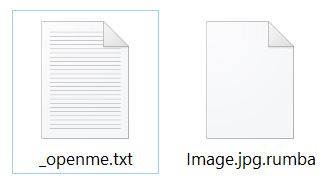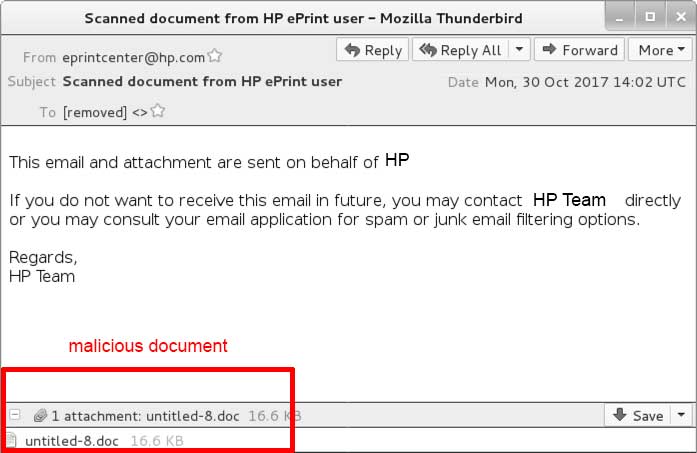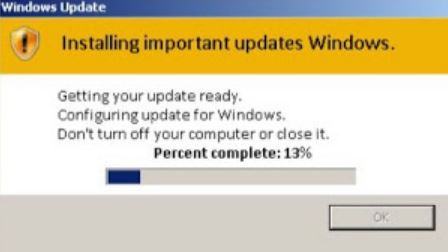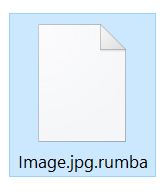
This blog post has been created with the main goal to explain what is the .rumba file variant of STOP ransomware and show you ways via which you can try and remove it from your computer.
A new ransomware virus going by the .rumba file extension has been detected by security researchers. The virus aims to append the .rumba file extension on the files that have been encrypted by it. The virus’s primary purpose is to convince victims to pay ransom in order to retrieve their files. If your computer system has been infected by the .rumba ransomware variant of STOP, we would suggest that you read this article.

Threat Summary
| Name | .rumba Files Virus |
| Type | Ransomware, Cryptovirus |
| Short Description | Variant of the [wplinkpreview url=”https://sensorstechforum.com/remove-stop-virus-restore-stop-files/”]STOP ransomware, part of the DJVU ransomware strain. Aims to encyrpt files on the compromised computer and then ask victims to pay ransom to get them back. |
| Symptoms | Files are encrypted with an added .rumba file extension. The virus then drops a ransom note, containing the extortion message. |
| Distribution Method | Spam Emails, Email Attachments, Executable files |
| Detection Tool |
See If Your System Has Been Affected by malware
Download
Malware Removal Tool
|
User Experience | Join Our Forum to Discuss .rumba Files Virus. |
| Data Recovery Tool | Windows Data Recovery by Stellar Phoenix Notice! This product scans your drive sectors to recover lost files and it may not recover 100% of the encrypted files, but only few of them, depending on the situation and whether or not you have reformatted your drive. |

.rumba Files Virus – Distribution Methods
The primary methods of distribution that are used by the .rumba ransomware are believed to be via e-mail spam campaigns, that are set to distribute malicious files attached to them, for example:
The files that are attached to the e-mails might be of the following file types:
- .JS (JavaScript files).
- .DOCX(Microsoft Word document with malicious macros).
- .PDF(Adobe Reader files).
- .EXE(Executables).
- .VBS (Visual Basic Script Files).
The malicious files can also be uploaded on suspicious websites, where they might pretend to be various different types of legitimate programs, such as:
- Portable software.
- Cracks.
- Patches.
- License Activators.
So far, the .rumba variant of STOP Ransomware was reported to be spread across the following countries:
- Poland
- Malaysia
- South Korea
- Thailand
- Indonesia
- Ukraine
- Venezuela
- Equador
- Chile
- Brasil
- Turkey
- Greece
- Egypt
- Others
Another way of replication which was recently reported by malware researcher Amigo A at id-ransomware.blogspot.com is to propagate via malicious Windows Update or programs that have already been previously compromised:

.rumba Files Virus – Infection Activity and Analysis
Rumba ransomware is a part of the STOP ransomware virus family of variants, most of which have been detected to use the following extensions:
- [wplinkpreview url=”https://sensorstechforum.com/remove-tfudet-files-virus/”].tfudet
- [wplinkpreview url=”https://sensorstechforum.com/tfudeq-ransomware-remove/”].tfudeq
- [wplinkpreview url=”https://sensorstechforum.com/djvut-files-virus-remove/”].djvut
- [wplinkpreview url=”https://sensorstechforum.com/djvur-ransomware-remove/”].djvur
- [wplinkpreview url=”https://sensorstechforum.com/remove-uudjvu-files-virus/”].udjvuu
- [wplinkpreview url=”https://sensorstechforum.com/udjvu-files-virus-remove/”].udjvu
- [wplinkpreview url=”https://sensorstechforum.com/djvuu-ransomware-remove-infections/”].djvuu
- [wplinkpreview url=”https://sensorstechforum.com/remove-adobe-stop-ransomware/”].adobe
- [wplinkpreview url=”https://sensorstechforum.com/remove-djvu-files-virus/”].djvu
- [wplinkpreview url=”https://sensorstechforum.com/remove-tfude-virus/”].tfude
- [wplinkpreview url=”https://sensorstechforum.com/blower-files-virus-remove/”].blower
- [wplinkpreview url=”https://sensorstechforum.com/remove-tro-files-virus/”].tro
And this is just a part of the many variants of [wplinkpreview url=”https://sensorstechforum.com/remove-stop-ransomware/”]STOP Ransomware virus. The virus is from the ransomware type which means that it aims to encode your files and then demand a huge sum, around $600 to pay in the time frame of 3 days to get the cyber-criminals to restore your files and if that Is not accomplished, the ransomware virus will likely increase the ransom payment.
The main infection file of .rumba virus has been reported by researchers and uploaded in VirusTotal with the following information:
→ SHA-256:48586462fb24005bcf8139ac2a8af0873b9bb99cb544fccaa24ac124c099beb9
File name:dump-2228224.mem
File size:347.5 KB
The virus file was reported to perform HTTP requests to domains that were related to rosalus.ug. The requests are as follows:
→ GET Request from hxxp://rosalos.ug/get_v2.php?pid=C28944D8AF49B3B7F79ED7D4845CB9B3
GET Request from hxxp://rosalos.ug/xxx/updatewin1.exe
In addition to this, the virus may use the following IP addresses to communicate:
- 77.123.139.189:443
- 185.120.56.96:80
Upon infection, the .rumba variant of STOP ransomware may open the follwing files on the infected computer:
→ \\.\PIPE\ROUTER
\\.\PIPE\lsarpc
c:\autoexec.bat
C:\48586462fb24005bcf8139ac2a8af0873b9bb99cb544fccaa24ac124c099beb9
C:\WINDOWS\Registration\R000000000007.clb
C:\WINDOWS\system32\rsaenh.dll
Furthermore, the virus may read and extract information from the following files:
→ c:\autoexec.bat
C:\48586462fb24005bcf8139ac2a8af0873b9bb99cb544fccaa24ac124c099beb9
C:\WINDOWS\Registration\R000000000007.clb
C:\WINDOWS\system32\rsaenh.dll
Shortly after this, .rumba STOP ransomware may copy the following object in the %AppData% directory of Windows:
→C:\Documents and Settings\
For some reason, the same file that was copied is later deleted from the same directory.
The .rumba file ransomware may also create the following process with deny parameters:
→icacls C:\Documents and Settings\
To synchronise, .rumba file ransomware may also create and open the mutex RasPbFile.
Upon infection, STOP .rumba ransomware may create the following system files of Windows:
→secur32.dll
shell32.dll
wsock32
ws2_32
comctl32.dll
rasapi32.dll
rtutils.dll
rpcrt4.dll
rasman.dll
c:\windows\system32\msv1_0.dll
sensapi.dll
ntdll.dll
userenv.dll
netapi32.dll
version.dll
wintrust.dll
schannel
urlmon.dll
wininet.dll
c:\windows\system32\mswsock.dll
dnsapi.dll
rasadhlp.dll
hnetcfg.dll
c:\windows\system32\wshtcpip.dll
c:\windows\system32\schannel.dll
clbcatq.dll
kernel32.dll
psapi.dll
rsaenh.dll
Then, the ransomware proceeds to it’s malicious activity of obtaining privileges as an administrator and then using those privileges to drop it’s payload, delete shadow copies, copy information and modify the Windows Registry Editor.
Once infected your computer, the .rumba files virus may drop It’s payload files in the following Windows directories;
- %Windows%
- %AppData%
- %Local%
- %LocalLow%
- %Roaming%
- %Temp%
Once having done that, the .rumba ransomware ma also drop it’s ransomware note file, which is believed to look like the following:
———————————————- ALL YOUR FILES ARE ENCRYPTED ———————————————–
Don’t worry, you can return all your files!
All your files documents, photos, databases and other important are encrypted with strongest encryption and unique key.
The only method of recovering files is to purchase decrypt tool and unique key for you.
This software will decrypt all your encrypted files.
What guarantees do we give to you?
You can send one of your encrypted file from your PC and we decrypt it for free.
But we can decrypt only 1 file for free. File must not contain valuable information
Don’t try to use third-party decrypt tools because it will destroy your files.
Discount 50% available if you contact us first 72 hours.—————————————————————————————————————————
To get this software you need write on our e-mail:
Reserve e-mail address to contact us:
Your personal ID:
[redacted 43 alphanumeric chars]
In addition to doing those activities, the .rumba files virus may also modify the Run and RunOnce Windows sub-keys on the computers of victims:
→ HKEY_LOCAL_MACHINE\Software\Microsoft\Windows\CurrentVersion\Run
HKEY_CURRENT_USER\Software\Microsoft\Windows\CurrentVersion\Run
HKEY_LOCAL_MACHINE\Software\Microsoft\Windows\CurrentVersion\RunOnce
HKEY_CURRENT_USER\Software\Microsoft\Windows\CurrentVersion\RunOnce
Furthermore, the .rumba files virus may also delete the shadow copies on the victim computer by running the following commands as an administrator:
→ sc stop VVS
sc stop wscsvc
sc stop WinDefend
sc stop wuauserv
sc stop BITS
sc stop ERSvc
sc stop WerSvc
cmd.exe /C bcdedit /set {default} recoveryenabled No
cmd.exe /C bcdedit /set {default} bootstatuspolicy ignoreallfailures
C:\Windows\System32\cmd.exe” /C vssadmin.exe Delete Shadows /All /Quiet

.rumba Ransomware – Encryption Process
For the .rumba files virus to encrypt the files on the compromised computer, the ransomware virus may first do a system scan of the files themselves. This scan will allow the virus to detect only the files it is set to encrypt and these files usually turn out to be:
- Audio files.
- Image files.
- Document file types.
- Video files.
- Archives.
- Virutal drives.
The .rumba files virus may begin to encrypt the files, by overwriting data blocks from their original structure. This makes the files unable to be opened and starting to appear like the image below shows:

Remove .rumba Files Virus and Try to Decrypt Your Files
If you want to remove the .rumba files virus, we suggest that you use the removal instructions underneath this article. They have been created to provide assistance to you in manually finding out and removing the malicious files of the .rumba ransowmare. But if manual removal does not seem to help, for maximume effectivness, we would suggest that you remove this virus using an anti-malware software, like most cyber-security experts would do. Such software aims to identify and delete all of the malicious objects, related to .rumba file ransomware from your computer and make sure to protect your computer in real time as well.
Fortunately, there is a decryption available for all the files, encrypted by most of the STOP ransomware variants and if the .rumba variant is part of the STOP ransomware, we would strongly recommend that you see the decryption tool for STOP ransomware if you want to restore your files. It is available on the following decryption tool link. Remember that for the decryption, you would eventually need to have one original file and it’s encrypted analogue file, so that you can decrypt all of your files this way.
- Step 1
- Step 2
- Step 3
- Step 4
- Step 5
Step 1: Scan for .rumba Files Virus with SpyHunter Anti-Malware Tool



Ransomware Automatic Removal - Video Guide
Step 2: Uninstall .rumba Files Virus and related malware from Windows
Here is a method in few easy steps that should be able to uninstall most programs. No matter if you are using Windows 10, 8, 7, Vista or XP, those steps will get the job done. Dragging the program or its folder to the recycle bin can be a very bad decision. If you do that, bits and pieces of the program are left behind, and that can lead to unstable work of your PC, errors with the file type associations and other unpleasant activities. The proper way to get a program off your computer is to Uninstall it. To do that:


 Follow the instructions above and you will successfully delete most unwanted and malicious programs.
Follow the instructions above and you will successfully delete most unwanted and malicious programs.
Step 3: Clean any registries, created by .rumba Files Virus on your computer.
The usually targeted registries of Windows machines are the following:
- HKEY_LOCAL_MACHINE\Software\Microsoft\Windows\CurrentVersion\Run
- HKEY_CURRENT_USER\Software\Microsoft\Windows\CurrentVersion\Run
- HKEY_LOCAL_MACHINE\Software\Microsoft\Windows\CurrentVersion\RunOnce
- HKEY_CURRENT_USER\Software\Microsoft\Windows\CurrentVersion\RunOnce
You can access them by opening the Windows registry editor and deleting any values, created by .rumba Files Virus there. This can happen by following the steps underneath:


 Tip: To find a virus-created value, you can right-click on it and click "Modify" to see which file it is set to run. If this is the virus file location, remove the value.
Tip: To find a virus-created value, you can right-click on it and click "Modify" to see which file it is set to run. If this is the virus file location, remove the value.
Before starting "Step 4", please boot back into Normal mode, in case you are currently in Safe Mode.
This will enable you to install and use SpyHunter 5 successfully.
Step 4: Boot Your PC In Safe Mode to isolate and remove .rumba Files Virus





Step 5: Try to Restore Files Encrypted by .rumba Files Virus.
Method 1: Use STOP Decrypter by Emsisoft.
Not all variants of this ransomware can be decrypted for free, but we have added the decryptor used by researchers that is often updated with the variants which become eventually decrypted. You can try and decrypt your files using the instructions below, but if they do not work, then unfortunately your variant of the ransomware virus is not decryptable.
Follow the instructions below to use the Emsisoft decrypter and decrypt your files for free. You can download the Emsisoft decryption tool linked here and then follow the steps provided below:
1 Right-click on the decrypter and click on Run as Administrator as shown below:

2. Agree with the license terms:

3. Click on "Add Folder" and then add the folders where you want files decrypted as shown underneath:

4. Click on "Decrypt" and wait for your files to be decoded.

Note: Credit for the decryptor goes to Emsisoft researchers who have made the breakthrough with this virus.
Method 2: Use data recovery software
Ransomware infections and .rumba Files Virus aim to encrypt your files using an encryption algorithm which may be very difficult to decrypt. This is why we have suggested a data recovery method that may help you go around direct decryption and try to restore your files. Bear in mind that this method may not be 100% effective but may also help you a little or a lot in different situations.
Simply click on the link and on the website menus on the top, choose Data Recovery - Data Recovery Wizard for Windows or Mac (depending on your OS), and then download and run the tool.
.rumba Files Virus-FAQ
What is .rumba Files Virus Ransomware?
.rumba Files Virus is a ransomware infection - the malicious software that enters your computer silently and blocks either access to the computer itself or encrypt your files.
Many ransomware viruses use sophisticated encryption algorithms to make your files inaccessible. The goal of ransomware infections is to demand that you pay a ransom payment to get access to your files back.
What Does .rumba Files Virus Ransomware Do?
Ransomware in general is a malicious software that is designed to block access to your computer or files until a ransom is paid.
Ransomware viruses can also damage your system, corrupt data and delete files, resulting in the permanent loss of important files.
How Does .rumba Files Virus Infect?
Via several ways..rumba Files Virus Ransomware infects computers by being sent via phishing emails, containing virus attachment. This attachment is usually masked as an important document, like an invoice, bank document or even a plane ticket and it looks very convincing to users.
Another way you may become a victim of .rumba Files Virus is if you download a fake installer, crack or patch from a low reputation website or if you click on a virus link. Many users report getting a ransomware infection by downloading torrents.
How to Open ..rumba Files Virus files?
You can't without a decryptor. At this point, the ..rumba Files Virus files are encrypted. You can only open them once they are decrypted using a specific decryption key for the particular algorithm.
What to Do If a Decryptor Does Not Work?
Do not panic, and backup the files. If a decryptor did not decrypt your ..rumba Files Virus files successfully, then do not despair, because this virus is still new.
Can I Restore "..rumba Files Virus" Files?
Yes, sometimes files can be restored. We have suggested several file recovery methods that could work if you want to restore ..rumba Files Virus files.
These methods are in no way 100% guaranteed that you will be able to get your files back. But if you have a backup, your chances of success are much greater.
How To Get Rid of .rumba Files Virus Virus?
The safest way and the most efficient one for the removal of this ransomware infection is the use a professional anti-malware program.
It will scan for and locate .rumba Files Virus ransomware and then remove it without causing any additional harm to your important ..rumba Files Virus files.
Can I Report Ransomware to Authorities?
In case your computer got infected with a ransomware infection, you can report it to the local Police departments. It can help authorities worldwide track and determine the perpetrators behind the virus that has infected your computer.
Below, we have prepared a list with government websites, where you can file a report in case you are a victim of a cybercrime:
Cyber-security authorities, responsible for handling ransomware attack reports in different regions all over the world:
Germany - Offizielles Portal der deutschen Polizei
United States - IC3 Internet Crime Complaint Centre
United Kingdom - Action Fraud Police
France - Ministère de l'Intérieur
Italy - Polizia Di Stato
Spain - Policía Nacional
Netherlands - Politie
Poland - Policja
Portugal - Polícia Judiciária
Greece - Cyber Crime Unit (Hellenic Police)
India - Mumbai Police - CyberCrime Investigation Cell
Australia - Australian High Tech Crime Center
Reports may be responded to in different timeframes, depending on your local authorities.
Can You Stop Ransomware from Encrypting Your Files?
Yes, you can prevent ransomware. The best way to do this is to ensure your computer system is updated with the latest security patches, use a reputable anti-malware program and firewall, backup your important files frequently, and avoid clicking on malicious links or downloading unknown files.
Can .rumba Files Virus Ransomware Steal Your Data?
Yes, in most cases ransomware will steal your information. It is a form of malware that steals data from a user's computer, encrypts it, and then demands a ransom in order to decrypt it.
In many cases, the malware authors or attackers will threaten to delete the data or publish it online unless the ransom is paid.
Can Ransomware Infect WiFi?
Yes, ransomware can infect WiFi networks, as malicious actors can use it to gain control of the network, steal confidential data, and lock out users. If a ransomware attack is successful, it could lead to a loss of service and/or data, and in some cases, financial losses.
Should I Pay Ransomware?
No, you should not pay ransomware extortionists. Paying them only encourages criminals and does not guarantee that the files or data will be restored. The better approach is to have a secure backup of important data and be vigilant about security in the first place.
What Happens If I Don't Pay Ransom?
If you don't pay the ransom, the hackers may still have access to your computer, data, or files and may continue to threaten to expose or delete them, or even use them to commit cybercrimes. In some cases, they may even continue to demand additional ransom payments.
Can a Ransomware Attack Be Detected?
Yes, ransomware can be detected. Anti-malware software and other advanced security tools can detect ransomware and alert the user when it is present on a machine.
It is important to stay up-to-date on the latest security measures and to keep security software updated to ensure ransomware can be detected and prevented.
Do Ransomware Criminals Get Caught?
Yes, ransomware criminals do get caught. Law enforcement agencies, such as the FBI, Interpol and others have been successful in tracking down and prosecuting ransomware criminals in the US and other countries. As ransomware threats continue to increase, so does the enforcement activity.
About the .rumba Files Virus Research
The content we publish on SensorsTechForum.com, this .rumba Files Virus how-to removal guide included, is the outcome of extensive research, hard work and our team’s devotion to help you remove the specific malware and restore your encrypted files.
How did we conduct the research on this ransomware?
Our research is based on an independent investigation. We are in contact with independent security researchers, and as such, we receive daily updates on the latest malware and ransomware definitions.
Furthermore, the research behind the .rumba Files Virus ransomware threat is backed with VirusTotal and the NoMoreRansom project.
To better understand the ransomware threat, please refer to the following articles which provide knowledgeable details.
As a site that has been dedicated to providing free removal instructions for ransomware and malware since 2014, SensorsTechForum’s recommendation is to only pay attention to trustworthy sources.
How to recognize trustworthy sources:
- Always check "About Us" web page.
- Profile of the content creator.
- Make sure that real people are behind the site and not fake names and profiles.
- Verify Facebook, LinkedIn and Twitter personal profiles.







Dear,
I would like to know if already decrypted file contaminated by RUMBA, for ID: ILVB810gCvHGkaDADuTbmq3dQsdSXyZT2bsuUicnV.